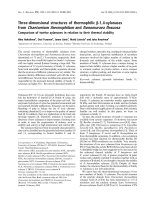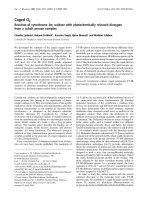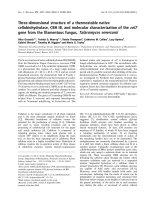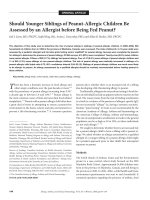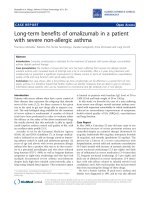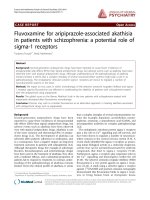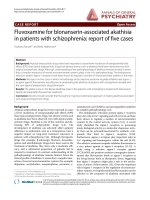Báo cáo y học: "Three dimensional evaluation of posture in standing with the PosturePrint: an intra- and inter-examiner reliability study" potx
Bạn đang xem bản rút gọn của tài liệu. Xem và tải ngay bản đầy đủ của tài liệu tại đây (804.15 KB, 11 trang )
BioMed Central
Page 1 of 11
(page number not for citation purposes)
Chiropractic & Osteopathy
Open Access
Research
Three dimensional evaluation of posture in standing with the
PosturePrint: an intra- and inter-examiner reliability study
Martin C Normand*
1
, Martin Descarreaux
1
, Donald D Harrison
1
,
Deed E Harrison
2
, Denise L Perron
3
, Joseph R Ferrantelli
4
and
Tadeusz J Janik
5
Address:
1
Département de chiropratique, Université du Québec à Trois-Rivières, Trois Rivieres, Québec, G9A 5H7, Canada,
2
Private Practice, Elko,
Nevada, USA,
3
Private Practice, Montréal, Québec, Canada,
4
Private Practice, New Port Richey, Florida, USA and
5
Comp Math R/C, 121 Todd
Whitt, Huntsville, AL 35806, USA
Email: Martin C Normand* - ; Martin Descarreaux - ;
Donald D Harrison - ; Deed E Harrison - ; Denise L Perron - ;
Joseph R Ferrantelli - ; Tadeusz J Janik -
* Corresponding author
Abstract
Background: Few digitizers can measure the complexity of upright human postural displacements
in six degrees of freedom of the head, rib cage, and pelvis.
Methods: In a University laboratory, three examiners performed delayed repeated postural
measurements on forty subjects over two days. Three digital photographs (left lateral, AP, right
lateral) of each of 40 volunteer participants were obtained, twice, by three examiners. Examiners
placed 13 markers on the subjects before photography and chose 16 points on the photographic
images. Using the PosturePrint
®
internet computer system, head, rib cage, and pelvic postures were
calculated as rotations (Rx, Ry, Rz) in degrees and translations (Tx, Tz) in millimeters. For reliability,
two different types (liberal = ICC
3,1
& conservative = ICC
2,1
) of inter- and intra-examiner
correlation coefficients (ICC) were calculated. Standard error of measurements (SEM) and mean
absolute differences within and between observers' measurements were also determined.
Results: All of the "liberal" ICCs were in the excellent range (> 0.84). For the more "conservative"
type ICCs, four Inter-examiner ICCs were in the interval (0.5–0.6), 10 ICCs were in the interval
(0.61–0.74), and the remainder were greater than 0.75. SEMs were 2.7° or less for all rotations and
5.9 mm or less for all translations. Mean absolute differences within examiners and between
examiners were 3.5° or less for all rotations and 8.4 mm or less for all translations.
Conclusion: For the PosturePrint
®
system, the combined inter-examiner and intra-examiner
correlation coefficients were in the good (14/44) and excellent (30/44) ranges. SEMs and mean
absolute differences within and between examiners' measurements were small. Thus, this posture
digitizer is reliable for clinical use.
Published: 24 September 2007
Chiropractic & Osteopathy 2007, 15:15 doi:10.1186/1746-1340-15-15
Received: 17 January 2007
Accepted: 24 September 2007
This article is available from: />© 2007 Normand et al; licensee BioMed Central Ltd.
This is an Open Access article distributed under the terms of the Creative Commons Attribution License ( />),
which permits unrestricted use, distribution, and reproduction in any medium, provided the original work is properly cited.
Chiropractic & Osteopathy 2007, 15:15 />Page 2 of 11
(page number not for citation purposes)
Background
Guidelines for evidence based care include postural eval-
uation as a primary physical examination procedure to be
performed on presenting patients [1,2]. For example, in
the fifth edition of the AMA guidelines, standing posture
evaluation is recommended as part of a comprehensive
but focused spine-related physical examination of the cer-
vical, thoracic, and lumbar spines [1].
Regarding postural measurement methods, there are sev-
eral tools available for clinical use. These include simple
photographic techniques and plumbline measures [3-6],
simple goniometers, inclinometers and linear devices [7-
9], placing known sized blocks between postural regions
[8], various computer assisted methods including electro-
goniometers [10], electromagnetic movement systems
[11,12], computer assisted digitization systems [13-15],
and 3D ultrasound-based motion analysis device for the
cervical spine [16].
In today's evidence based health care arena, it is unaccept-
able to evaluate patients with non-objective measures.
Computerized postural digitization/assessment proce-
dures should allow for accurate quantitative evaluation of
postural impairments so that improvement or worsening
of a patient's abnormality can be succinctly documented.
Validity and reliability of each particular device/system
needs to be studied. Several computer assisted postural
measurement systems have been studied for measure-
ment reliability [10-16]. Problematically, several of these
investigations have suffered from an incomplete analysis,
including use of only one examiner, small sample sizes,
and measurement of only one region of the body, or a
limited number of degrees of freedom of postural dis-
placements [10-16].
Recently, a computerized system, PosturePrint
®
, was
developed to measure head, rib cage, and pelvic postures
as rotations and translations in three-dimensions (3-D) in
upright stance. In two separate validity studies, the Pos-
turePrint
®
system was found to be sufficiently accurate in
measuring head and thoracic cage postures in five degrees
of freedom [17,18].
It is the purpose of the present study to evaluate the intra
and inter-examiner reliability of the process required for
the PosturePrint
®
computer system's analysis of upright
human posture. It was hypothesized that the Posture-
®
would be sufficiently reliable for postural measure-
ments in the clinical setting.
Methods
Subjects
Forty student participants underwent a posture evaluation
by three examiners, randomly, once each on consecutive
days in a University laboratory. The examiners had used
the PosturePrint
®
system previously in their own practices
for at least six months. They were not privy to the results
of each other's measurements. The study was approved by
the Ethics Committee at the University of Quebec in Trois
Rivieres, Canada. Participants reviewed the approved
Institutional Review Board (IRB) study protocol, provided
informed consent for their participation, and their rights
were protected.
Since we desired to determine the health status of our par-
ticipants, participants filled out a four-part Numerical Rat-
ing Scale (NRS) of 0–10, (with 0 being no pain and 10
being severe pain), and an SF-36 health questionnaire.
Study protocol
The posture analysis was performed with the Posture-
®
computer system. The PosturePrint
®
computer sys-
tem requires a set of three photographs of each
participant: left lateral, antero-posterior (AP), and right
lateral. Photographs are obtained with a digital camera.
The camera height is at 83.8 cm (33 inches) above the
floor and the camera is placed 2.74 m (9 feet) from a cal-
ibrated wall grid on a perpendicular line from mid-wall
grid. Three such camera and wall grid stations were set up
in the University's laboratory with partitions between sta-
tions.
Participants stood 61 cm (two feet) from the center of the
wall grid. In the AP view, along a line perpendicular from
the center of the wall grid, participants positioned their
feet such that the perpendicular bisected mid stance.
While setting up the wall grid and camera, from mid wall
grid, a perpendicular was drawn on the floor outward for
2.74 m. The camera was placed on this line. In each of the
two lateral views, the participants' ankles were placed such
that the mid ankle bisection was directly inline with the
perpendicular from mid wall grid. In this manner, each
participant was positioned with their feet centered relative
to the camera and grid reference frame.
The participants were asked to wear tight fitting clothes in
order for examiners to find various anatomical sites. The
examiners (two of whom are co-authors) placed 13 mark-
ers on each participant before taking the three photo-
graphs. For the photographs, participants were instructed
to stand, nod their head up and down twice with their
eyes closed and then assume what they felt to be a neutral
body posture. In this stance, the eyes were opened and the
subject refrained from motion. (Figure 1) This postural
positioning procedure has been shown to be reliable
Chiropractic & Osteopathy 2007, 15:15 />Page 3 of 11
(page number not for citation purposes)
[6,19]. Each examiner palpated anatomical locations and
placed his/her own reflective markers, took the three pho-
tographs, and removed the markers from each participant
before the participant proceeded to the next examiner's
camera and wall-grid station. On the digital photographs,
using the computer mouse, examiners chose an addi-
tional 16 points (Figures 2 and 3). The set of photographs
was processed through a secure internet website, where
only the coordinates of the markers are available to the
computer program (i.e., it is USA HIPAA compliant,
Health Insurance Portability and Accountability Act).
All three examiners performed this procedure on all par-
ticipants twice in two days (80 sets of three photographs).
Examiners evaluated twenty participants in two hours
during each of two mornings and twenty participants in
two hours in the afternoons. Participants were in random
order because they were evaluated in the order that they
arrived at the beginning station. For each examiner, this
resulted in a participant photographic evaluation every 3–
6 minutes. Each examiner was given a computer disk with
his/her 80 sets of photographs, numbered to blind exam-
iners from names, occasions, and patient characteristics,
and was asked to evaluate these on the web site featuring
the PosturePrint® over the next two weeks. The data was
stored on the web site and accessed by the lead investiga-
tor.
AP view anatomical markersFigure 2
AP view anatomical markers. The examiners placed thir-
teen reflective markers at anatomical locations, which were
automatically recognized by the PosturePrint
®
computer
program, and used the computer mouse to click-on/identify
16 more anatomical points. (Reprinted with permission from
Biotonix, Montreal, Quebec, Canada)
Participant with markers before photographyFigure 1
Participant with markers before photography. This
figure shows one of the three photographs (left lateral view)
used in the setting used for this posture reliability study in a
university laboratory.
Chiropractic & Osteopathy 2007, 15:15 />Page 4 of 11
(page number not for citation purposes)
Using the (x, y)-coordinates and (y, z)-coordinates from
the markers on the photographs, the PosturePrint
®
com-
puter code calculates the static postures of the head, rib
cage, and pelvis as rotations (Rx, Ry, Rz) in degrees and
translations (Tx, Tz) in millimeters as displacements from
a normal upright stance (Figures 4 and 5). Vertical trans-
lation (Ty) is not calculated since the center of mass
(COM) can not move vertically in static stance.
Examiner error analysis
If we denote by Y
ijk
the observation on participant i (i =
1, , 40) by examiner j (j = 1,2,3) on day k (k = 1,2), then
for a first error analysis, mean absolute values of the dif-
ferences within examiners' measurements (MADOM)
were calculated as:
For a second more conservative error analysis, mean abso-
lute values of the differences between examiners' measure-
ments (MADBO) were calculated as:
Intraclass correlation coefficients
Our methodology provided three sets of intra-examiner
data and three sets of inter-examiner data. Inter- and intra-
class correlation coefficients (ICCs) were calculated for
each of 15 variables (measurement type). We provided
two different methods of calculating ICCs, Standard
Errors of Measurement (SEM), and Differences in Exam-
iner's Measurements for a conservative (ICC
2,1
) and a
more usual (liberal, ICC
3,1
) analysis of our data. The use
of ICCs require a normal distribution of the data, which
was determined with the Shapiro-Wilk test.
For the ICC
2,1
method, all statistical calculations were
done using SAS 9.0 (SAS Institute, Inc. Cary, NC, USA).
For the liberal method (ICC
3,1
), ANOVAs were computed
using Statistica for windows (2001) Version 6.0 (Statsoft,
Tulsa, OK, USA).
Standard error of measurement (SEM)
According to Weir [20], ICCs are a relative measure of reli-
ability, while the Standard Error of Measurement (SEM)
provides an absolute index of reliability. Therefore, SEMs
were calculated for both ICC methods, of which the con-
servative method has the lowest ICCs and highest SEMs. If
SD represents the standard deviation of the scores from all
subjects, then from Weir [20]:
Results
The participants were composed of 30 females and 10
males, with a mean age of 24.4 years (SD = 1.9). Their
mean height was 168.8 cm (SD = 8.5) and mean weight
was 62.5 kg (SD = 11.2). The four-part numerical rating
scores (NRS) for pain and Short Form questionnaire (SF-
36) scores indicated a near normal group
(Tables 1 and 2).
We noted that for four variables (RyHead, RyThorax,
RyPelvis, and RzPelvis), the assumption of having a nor-
mal distribution was violated. For these variables, values
were closely distributed with many identical values mak-
ing it inappropriate to calculate ICCs. In such cases, exam-
MADOM =−
(
)
==
∑∑
YY
ij ij
ji
12
1
3
1
40
120/.
(1)
MADBO =−
(
)
′′
′
=≠
′
==
∑∑∑
YY
ijk ij k
kkjji .
/.
1
2
1
3
1
40
480
(2)
SEM SD ICC=⋅−1.
(3)
Lateral view anatomical markersFigure 3
Lateral view anatomical markers. The examiners placed
13 reflective markers at anatomical locations, which were
automatically recognized by the PosturePrint
®
computer
program, and used the computer mouse to click-on/identify
16 more anatomical points. The computer program calcu-
lated postural displacements using these markers. Illustrated
here are the markers easily visualized in the lateral view.
(Reprinted with permission from Biotonix, Montreal, Que-
bec, Canada)
Chiropractic & Osteopathy 2007, 15:15 />Page 5 of 11
(page number not for citation purposes)
Postural rotationsFigure 4
Postural rotations. Using a right-handed Cartesian coordinate system with X-axis positive to the left, Y-axis positive verti-
cally, and Z-axis positive to the anterior, postures of the head, rib cage, and pelvis can be described as rotations (Rx, Ry, Rz)
around these axes.
Chiropractic & Osteopathy 2007, 15:15 />Page 6 of 11
(page number not for citation purposes)
Postural translationsFigure 5
Postural translations. Using a right-handed Cartesian coordinate system with X-axis positive to the left, Y-axis positive ver-
tically, and Z-axis positive to the anterior, postures of the head, rib cage, and pelvis can be described as translations (Tx, Ty,
Tz) along these axes. Vertical translations (Ty), which would require radiographic analysis of hypo- or hyper-lordosis, were not
calculated in the present study.
Chiropractic & Osteopathy 2007, 15:15 />Page 7 of 11
(page number not for citation purposes)
iner agreement is high but inappropriately calculated
ICCs may be artificially low [20]. For such situations, it is
more informative to consider the SEM [20]. For these four
variables, the more conservative SEMs are 0.9°, 1.2°,
1.2°, and, 1.3°, respectively, which indicates excellent
reliability. Table 3 provides SEMs for all fifteen variables
for the conservative ICC method. These SEMs are 2.7° or
less for all rotations and 5.9 mm (approximately 1/4 inch)
or less for all translations.
Conservative ICCs
The conservative method of calculating ICCs (ICC
2,1
)
often has inter-examiner ICCs lower than other ICC meth-
ods by approximately 0.1 [21]. For the 11 variables (out
of 15) for which ICCs were appropriate, all the conserva-
tive intra- and inter-examiner ICCs were in the good range
(0.5 < ICC < 0.75) or excellent range (ICC ≥ 0.75) [22]. In
general, the intra-examiner ICCs (seven out of eleven were
greater than 0.75) were higher than the inter-examiner
ICCs. Only four of the inter-examiner ICCs were in the
lower portion of the good range (0.5 < ICC < 0.60) and
seven inter-examiner ICCs were greater than 0.60, while
one (Tz of the Pelvis) was in the excellent range. For the
variables for which these conservative ICC values are in
the good range (0.5 < ICC < 0.75), we note that the stand-
ard deviations are small (Table 3), indicating participants
differ little from each other [20]. For these variables, SEMs
are more informative [20]. The small SEMs in Table 3
indicate high reliability. Table 3 provides the details of
this conservative analysis with means, standard devia-
tions, SEMs, ICCs, and 95% confidence intervals.
Liberal ICCs
For the 11 variables (out of 15) for which ICCs were
appropriate, all of the intra- and inter-examiner ICCs for
this more liberal method (ICC
3,1
) were greater than 0.84,
which is in the excellent range as defined by Shrout and
Fleiss (ICC ≥ 0.75) [22] and in the almost perfect range as
suggested by Dunn (ICC > 0.80) [23]. Table 4 provides
SEMs, intra- and inter-examiner correlation coefficients,
and 95% confidence intervals.
Error analysis
Two types of error analysis were computed from equa-
tions 1 and 2. Since each examiner had two measurements
for each variable, three examiners provided three pairs of
differences of first and second measurements. The more
liberal MADOM averaged the three pairs of differences
within the same examiner over all subjects [24].
However, if the first and second measurements for each
examiner were not compared to each other, but to each of
the measurements of the other examiners, then there were
twelve pairs of differences for each variable. The more
conservative MADBO error analysis averaged all of the 12
pairs of differences for different examiners over all sub-
jects.
The mean absolute differences between examiners'
(MADBO) measurement results were 6 mm (≈ 1/4 inch)
or less for lateral translations (TxH, TxT, TxP) and 8.4 mm
(1/3 inch) or less for forward translational measurements
(TzH, TzT, TzP). The MADBO were 3.5° or less for flexion-
extension rotational measurements (RxH, RxT, RxP) and
1.9° or less for all axial rotations (RyH, RyT, RyP) and lat-
eral bending rotations (RzH, RzT, RzP). Table 3 provides
all the MADBO results.
The mean absolute differences within examiners' meas-
urements (MADOM) results were 4 mm (≈ 1/6 inch) or
less for lateral translations (TxH, TxT, TxP) and 7.1 mm (≈
1/4 inch) or less for forward translational measurements
(TzH, TzT, TzP). The MADOM were 3.2° or less for flex-
ion-extension rotational measurements (RxH, RxT, RxP)
and 1.4° or less for all axial rotations (RyH, RyT, RyP) and
lateral bending rotations (RzH, RzT, RzP). Table 4 pro-
vides the MADOM results.
Discussion
This study assessed the intra and inter-examiner reliability
of standing posture with a new computerized postural
digitizer, PosturePrint
®
, using three examiners, who evalu-
Table 2: The Short Form questionnaire (SF36) for activities of daily living in the forty volunteer subjects
health
perception
physical
functioning
role physical role
emotional
social
functioning
mental health bodily pain energy fatigue
Mean ±
Standard
Deviation
88.4 ± 7.5 98.9 ± 3.1 95.0 ± 18.1 80.8 ± 35.3 83.9 ± 19.6 71.3 ± 14.8 84.6 ± 14.3 62.0 ± 16.7
Table 1: Numerical Rating Scale (NRS:0,1, , 10) for pain in the
forty volunteer subjects at different times during a typical day.
NRS Now NRS Average NRS Best NRS Worst
Mean ±
Standard
deviation
1.0 ± 1.3 1.1 ± 1.7 0.05 ± 0.2 3.5 ± 3.2
Chiropractic & Osteopathy 2007, 15:15 />Page 8 of 11
(page number not for citation purposes)
Table 3: PosturePrint
®
reliability analysis with a conservative ICC method (ICC
2,1
). Three examiners evaluated forty student
volunteers, with a posture digitizer, twice over 2 days.
Measure Mean SD* SEM† InterICC‡ 95% C.I. § Intra ICC‡ 95% C.I. MADBO||
Pelvis Rx 3.2° 4.5 2.4° 0.56 0.44–0.68 0.72 0.59 – 0.82 3.3° ± 2.6
Thorax Rx -3.1° 3.1 1.5° 0.65 0.53–0.76 0.76 0.64 – 0.86 2.3° ± 1.7
Head Rx -1.2° 5.7 2.7° 0.69 0.58–0.79 0.77 0.66 – 0.86 3.5° ± 2.7
Pelvis Ry -0.3° 1.1 0.9° N/A¶ N/A N/A N/A 0.6° ± 1.2
Thorax Ry 0.2° 1.3 1.2° N/A N/A N/A N/A 1.0° ± 1.4
Head Ry -0.1° 1.8 1.2° N/A N/A N/A N/A 1.6° ± 1.3
Pelvis Rz -0.3° 1.5 1.3° N/A N/A N/A N/A 1.5° ± 1.3
Thorax Rz 0.3° 1.4 0.7° 0.66 0.55–0.77 0.76 0.66–0.85 1.0° ± 0.8
Head Rz 1.1° 2.3 1.2° 0.66 0.55–0.77 0.75 0.64–0.84 1.9° ± 1.3
Pelvis Tx -3.6 mm 7.1 4.3 mm 0.51 0.39 – 0.64 0.64 0.51 – 0.76 6.0 mm ± 4.3
Thorax Tx 2.0 mm 6.5 2.6 mm 0.72 0.62 – 0.82 0.84 0.74 – 0.90 4.2 mm ± 3.2
Head Tx -0.6 mm 6.0 3.4 mm 0.54 0.42 – 0.67 0.67 0.54 – 0.78 5.2 mm ± 3.9
Pelvis Tz 54.4 mm 17.0 5.9 mm 0.80 0.71 – 0.87 0.88 0.81 – 0.93 8.4 mm ± 6.3
Thorax Tz 3.6 mm 9.8 5.5 mm 0.54 0.41 – 0.68 0.68 0.52 – 0.81 8.3 mm ± 6.0
Head Tz 30.1 mm 9.1 4.6 mm 0.64 0.52 – 0.75 0.75 0.64 – 0.84 6.0 mm ± 4.6
* SD = Standard deviation
† SEM = Standard error of measurement = .
‡ ICC = Cross factor intra- or inter-examiner correlation coefficient
§ 95% C.I. = 95 percent confidence interval
|| MADBO = Mean absolute differences between observers' measurements
¶ N/A = Not applicable, means the assumption of a normal distribution was violated by many identical values, and thus ICCs are not appropriate for
this data.
SD ICC⋅−1
Table 4: PosturePrint
®
reliability with a liberal ICC method (ICC
3,1
). Forty student volunteers at a university were evaluated, with a
posture digitizer, twice by three examiners, with a one-day delay.
Measure SEM* InterICC† 95% C.I. ‡ Intra ICC† 95% C.I. MADOM§
Pelvis Rx 1.3° 0.88 0.81–0.93 0.92 0.80 – 0.94 2.6° ± 2.1
Thorax Rx 0.9° 0.93 0.88–0.96 0.92 0.81 – 0.94 1.6° ± 1.3
Head Rx 1.5° 0.95 0.92–0.97 0.93 0.82 – 0.94 3.2° ± 2.5
Pelvis Ry 0.4° N/A|| N/A N/A N/A 0.6° ± 1.2
Thorax Ry 0.8° N/A N/A N/A N/A 0.9° ± 1.4
Head Ry 0.6° N/A N/A N/A N/A 1.1° ± 1.0
Pelvis Rz 0.9° N/A N/A N/A N/A 1.4° ± 1.4
Thorax Rz 0.4° 0.93 0.89–0.96 0.92 0.79–0.94 0.7° ± 0.6
Head Rz 0.6° 0.94 0.90–0.97 0.94 0.84–0.95 1.1° ± 0.8
Pelvis Tx 1.7 mm 0.89 0.82 – 0.94 0.94 0.85 – 0.96 3.9 mm ± 3.1
Thorax Tx 1.7 mm 0.94 0.90 – 0.97 0.93 0.82 – 0.95 3.3 mm ± 2.5
Head Tx 2.3 mm 0.89 0.83 – 0.94 0.85 0.64 – 0.88 4.0 mm ± 2.8
Pelvis Tz 2.9 mm 0.96 0.94 – 0.98 0.97 0.91 – 0.97 7.1 mm ± 5.6
Thorax Tz 2.9 mm 0.89 0.82 – 0.93 0.91 0.78 – 0.93 5.7 mm ± 4.5
Head Tz 2.6 mm 0.93 0.88 – 0.96 0.92 0.79 – 0.93 5.4 mm ± 4.7
* SEM = Standard error of measurement = .
† ICC = Intra- or inter-examiner correlation coefficient
‡ 95% C.I. = 95 percent confidence interval
§ MADOM = Mean absolute differences of observers' measurements
|| N/A = Not applicable, means the assumption of a normal distribution was violated by many identical values, and thus ICCs are not appropriate for
this data.
SD ICC⋅−1
Chiropractic & Osteopathy 2007, 15:15 />Page 9 of 11
(page number not for citation purposes)
ated forty subjects each on two different occasions. It had
been hypothesized that the PosturePrint
®
would be a reli-
able method to evaluate head, rib cage, and pelvic posture
as three rotations and two translations or five degrees of
freedom (DoF). In fact for 11 out of 15 variables (a total
of 44 Intra- and Inter-examiner ICCs), 14 (32%) were in
the good range (0.50 < ICC < 0.75) and 30 (68%) were in
the excellent range (ICC > 0.75) [22]. For the four postural
variables, for which ICCs were inappropriate, small SEMs
(1.3° or less for these axial and lateral flexion rotations)
indicate excellent reliability. Additionally for all variables,
small SEMs and small mean absolute errors (two types)
indicate close examiner agreement. Thus, the data indicate
that the PosturePrint
®
is rated good to excellent for relia-
bility of measuring standing posture.
Study limitations
One possible limitation of this study might be the fact
that our participant population represented a relatively
asymptomatic population with an average NRS of 1.1 ±
1.7. However, postural analysis has been shown to be
repeatable in a variety of pain populations as well as
asymptomatic groups [19]. Some evidence in recent acute
whiplash injured subjects suggested that head position
sense is not repeatable [25], but certain measures (forward
head posture) in this group have been found to be reliable
[9].
Sources of error in the PosturePrint
®
systems' analysis of
posture included: possible variation in upright stance
from day to day, inherent errors due to placing markers
from palpation of boney landmarks [26], errors involved
in the choosing of sixteen points on the photographs via
the computer mouse by each examiner, and errors in posi-
tioning the participants in the same manner relative to the
reference wall grid and camera [27]. However, the high
ICCs, small SEMs, and low mean absolute differences
between and within examiners' measurements indicate
that these sources of error were kept at a minimum.
Another limitation might be the choice of the ICC
method used [13,20,28,29]. The definition of the ICC
method depended on the assumptions of (a) whether
each of examiners, time, and participants was a fixed or
random factor and (b) the type of error included (true
score variance, systematic and/or random) [28]. In the
equation for calculating ICCs, this changed the denomi-
nator [20]. For the conservative method, it was assumed
that measurement was crossed with examiner and partici-
pant, and examiner, participant, and occasion were all
random factors. This enlarged the denominator in the def-
initions of the conservative ICCs, making ICCs smaller.
Additionally, the magnitude of an ICC depended on the
between-participants variability [20]. By providing both a
liberal and conservative methods and SEMs for each
method, we have reduced any limitations due to choice of
an ICC method.
Depending on the ICC type of equations used, between
30 and 60 participants would be necessary for a conclu-
sion of reliability to be made [21,30]. Estimations from
Eliasziw et al. [29] suggest that for 0.9 reliability and two
repeated measurements, 40 participants were more than
adequate for a 5% significance with 80% power. Because
of this, the current investigators used 40 participants with
three examiners assessing each participant twice with a
one day interval between measurements.
According to Weir [20], "there are six common versions of
the ICC (and four others as well), and the choice of which
version to use is not intuitively obvious." Additionally,
there are 10 ICC versions presented by McGraw and Wong
[28]. This is the reason why we decided to report two types
of ICCs to be calculated for each of fifteen variables, a
more liberal method and a more conservative method.
The two sets of ICCs were calculated under slightly differ-
ent tenable model assumptions. For the conservative type,
measurement was crossed with examiner and participant,
and examiner was a random factor [21]. Results from this
type of ICC (a generalization of ICC
2,1
) can be generalized
to subject and examiner populations [20].
The liberal ICC method assumed that the three factors
(examiner, participant, occasion) were fixed and used a
two-way repeated-measures ANOVA model. Two-way ICC
models (this liberal ICC type is ICC
3,1
) required occasions
or examiners to be crossed with participants (i.e., each
examiner evaluated all participants on each occasion in
the present study) [20]. Use of this ICC type restricted
how the results can be generalized. However, it can be
used to identify the limits and pitfalls of postural analysis
(e.g.: marker placement).
Therefore, the denominator in the equation to compute
the liberal ICCs were the sum of two terms, while the
denominators of the conservative ICCs were the sum of
three terms, which makes the conservative ICCs smaller
than the liberal ICCs.
Previous studies
A few studies have investigated the repeatability of pos-
tural measures using computer assisted devices [10-16].
Some studies did not report reliability in terms of ICCs
[10,15]. However, we noted that some studies have
reported small ICCs and claimed poor posture reliability
[12-15], when in fact, their data suggested that ICCs were
inappropriate for certain variables. According to Weir
[20], there were at least two instances when ICCs are not
informative: (a) when multiple repeated measured values
Chiropractic & Osteopathy 2007, 15:15 />Page 10 of 11
(page number not for citation purposes)
occur in the data and (b) when data is homogenous. ICCs,
of any type, should not be used on measurements that are
mostly one value because this violated a basic ANOVA
assumption that the data were approximately normally
distributed. This meant that the data must be spread out
over a continuum, with concentration in the middle and
symmetry about the middle. If there was a normal distri-
bution, but the distribution had a very small standard
deviation, then Weir stated [20], "if subjects differ little
from each other, ICC values are small even if trial-to-trial
variability is small." Weir's ideas may apply to two recent
studies by Dunk et al [13,14].
Dunk et al. [13] performed a reliability study of a photo-
graphic technique and consequent digitization of reflec-
tive landmarks with 14 participants and reported poor to
moderate ICCs for posture reliability. After a letter to the
editor [27] critical of their 2004 study [13], in a follow up
study [14], Dunk et al. assessed the intra-examiner relia-
bility with more (20) healthy participants. Dunk et al.
concluded that their sagittal plane measures were more
reliable than coronal plane measures, but their sagittal
plane angles of spinal curvature had mean error of
approximately 6° while their coronal plane bending had
mean error less than 2° [14]. Because Dunk et al. [14] had
an error of 6° with high ICCs for the sagittal plane, but a
very small error of 2° with low ICCs for the coronal plane,
it may be that either multiple values occurred in Dunk et
al's data or their participants were quite similar. Thus,
their conclusions of poor reliability for coronal plane
bending may be incorrect.
Using an electromagnetic device, Swinkles and Dolan
examined the ability of healthy individuals to reposition
their thoraco-lumbar regions in both sagittal and coronal
planes (two DoF) [11,12]. Intra-day and inter-day
repeated measures were found to be 5° or less for sagittal
displacements and 2.5° or less for coronal displacements.
Although, Swinkles and Dolan [11,12] found some ICCs
to be in the poor range, they commented that several of
their displacement values were very small and approached
the limit of accuracy of their measurement device. Here,
the use of ICCs on these variables was inappropriate as
explained above (see Weir [20]). Consequently, consider-
ing the small repositioning errors, they concluded that
"healthy volunteers were able to reposition their spine
with considerable accuracy as measured with the 3-Space
Fastrak" [11].
In another reliability study of posture, using an ultrasonic
digitizer (Zebris) method of cervical range of motion
measurements, Strimpakos et al. stated that their method
employed for measuring cervical joint position sense was
unreliable [16].
Posture reliability design suggestions
According to the above review, there were a variety of
methodological concerns with reported reliability studies
in the literature. For example, many investigations uti-
lized only one examiner and it was possible that this
examiner could have made gross mistakes from one exam-
ination to the next, causing poor intra-examiner reliabil-
ity. Statistically, therefore, multiple examiners were
needed to average any artificially low or high intra-exam-
iner data, which would provide a more reasonable mean.
It has been suggested that a minimum of three examiners
each performing an analysis at least twice was needed for
any conclusions to be drawn about inter- and intra-exam-
iner reliability [30]. In the current investigation of the Pos-
turePrint
®
system, we have followed this
recommendation.
Lastly, depending upon the mean value and distribution
of the specific postural displacement recorded, ICCs may
be inappropriate as they cannot give a clinically relevant
picture of the true error. Because of this, in the current
investigation, we analyzed the Standard Error of Measure-
ment (SEM) and mean absolute differences within
(MADOM) and between (MADBO) examiners' measure-
ments for each postural degree of freedom. The SEMs were
small (2.7° or less for all rotations and 5.9 mm (≈ 1/4
inch) or less for all translations). The MADOM values
were found to be 4 mm or less for lateral translations and
7.1 mm or less for forward translations. The MADOM val-
ues were 3.2° or less for flexion-extension rotational
measurements and 1.4° or less for all axial rotations and
lateral bending rotations. The MADBO values were found
to be 6 mm or less for lateral translations and 8.4 mm or
less for forward translations. The MADBO values were
3.5° or less for flexion-extension rotational measure-
ments and 1.9° or less for all axial rotations and lateral
bending rotations.
Since the PosturePrint
®
system has adequate reliability,
there were several possible future studies. A study on
healthy subjects could provide a normative database.
Studies on patients could provide any differences from
normal. Correlations between different postures and
health conditions are possible, and pre- and post-treat-
ment clinical trials with various technique methods are
also possible studies.
Conclusion
When three examiners evaluated 40 participants twice
with a posture digitizer, the PosturePrint
®
, it was found to
be highly reliable. The SEMs were small, observers' errors
were small, and the combined 44 inter-examiner and
intra-examiner correlation coefficients were in the good
(14/44) and excellent (30/44) ranges for clinical research.
Thus, the PosturePrint
®
computer system was determined
Publish with BioMed Central and every
scientist can read your work free of charge
"BioMed Central will be the most significant development for
disseminating the results of biomedical research in our lifetime."
Sir Paul Nurse, Cancer Research UK
Your research papers will be:
available free of charge to the entire biomedical community
peer reviewed and published immediately upon acceptance
cited in PubMed and archived on PubMed Central
yours — you keep the copyright
Submit your manuscript here:
/>BioMedcentral
Chiropractic & Osteopathy 2007, 15:15 />Page 11 of 11
(page number not for citation purposes)
to be highly reliable for measuring neutral standing pos-
ture.
Competing interests
Six authors declare that they have no competing interests,
while one author (DDH) has a financial agreement with
Biotonix, which provides the web service for PosturePrint.
Authors' contributions
All authors contributed to the research design (MN, MD,
DDH, DEH, DP, JF, TJ). MN, DDH, DP, and JF collected
the data. MD and TJ analyzed the data. All authors partic-
ipated in drafting the manuscript. All authors read and
approved the final manuscript
Acknowledgements
Data Collection: Marin Wendell, BS, DC
Statistical Consultant: Burt Holland, PhD, Temple University, Philadelphia,
PA, USA
SUPPORT: Université du Québec à Trois-Rivières, Trois-Rivières, Québec,
Canada
CBP, Nonprofit, Inc, Evanston, WY, USA.
Use of Photograph: Marie-Elaine Normand.
References
1. Cocchiarell L, Andersson GBJ: Guides to the Evaluation of Permanent
Impairment 5th edition. AMA Press; 2001:375.
2. Haldeman S, Chapman-Smith D, Petersen DM: Guidelines for chiroprac-
tic quality assurance and practice parameters. Proceedings of the Mercy
Center Consensus Conference Aspen Publishers, Inc., Gaithersburg,
Maryland; 1993. 38, 40, 147,152
3. Zonnenberg AJJ, Maanen V, Elvers JWH, Oostendorp RAB: Intra/
interrater reliability of measurements on body posture pho-
tographs. J Craniomandibular Practice 1996, 14:326-331.
4. Raine S, Twomey LT: Head and shoulder posture variations in
160 asymptomatic women and men. Arch Phys Med Rehabil
1997, 78:1215-1221.
5. Vernon H: An assessment of the intra- and inter-reliability of
the posturometer. J Manipulative and Physiol Ther 1983, 6:57-60.
6. Bullock-Saxton J: Postural alignment in standing: a repeatable
study. Austr Physiother 1993, 39:25-29.
7. Braun BL, Amundson LR: Quantitative assessment of head and
shoulder posture. Arch Phys Med Rehabil 1989, 70:322-9.
8. Grimmer K: An investigation of poor cervical resting posture.
Australian Physiotherapy 1997, 43:7-16.
9. Nilsson BM, Soderlund A: Head posture in patients with whip-
lash-associated disorders and the measurement method's
reliability – A comparison to healthy subjects. Advances in Phys-
iotherapy 2005, 7:13-19.
10. Christensen HW, Nilsson N: The ability to reproduce the neu-
tral zero position of the head. J Manipulative Physiol Ther 1999,
22:26-28.
11. Swinkels A, Dolan P: Spinal position sense is independent of the
magnitude of movement. Spine 2000, 25:98-105.
12. Swinkels A, Dolan P: Regional assessment of joint position
sense in the spine. Spine 1998, 23:590-597.
13. Dunk NM, Chung YY, Compton , Callaghan JP: The reliability of
quantifying upright standing postures as a baseline diagnos-
tic clinical tool. J Manipulative Physiol Ther 2004, 27:91-96.
14. Dunk NM, Lalonde J, Callaghan JP: Implications for the use of pos-
tural analysis as a clinical diagnostic tool: reliability of quan-
tifying upright standing spinal postures from photographic
images. J Manipulative Physiol Ther 2005, 28:386-392.
15. Beaudoin L, Zabjek KF, Leroux MA, Coillard C, Rivard CH: Acute
systematic and variable postural adaptations induced by an
orthopaedic shoe lift in control subjects. Eur Spine J 1999,
8:40-45.
16. Strimpakos N, Sakellari V, Gioftsos G, Papathanasiou M, Brountzos E,
Kelekis D, Kapreli E, Oldham J: Cervical spine ROM measure-
ments: optimizing the testing protocol by using a 3D ultra-
sound-based motion analysis system. Cephalgia 2005,
25:1133-45.
17. Harrison DE, Janik TJ, Cailliet R, Harrison DD, Normand MC, Perron
DL, Ferrantelli J: Validation of a Computer Analysis to Deter-
mine 3-D Rotations and Translations of the Rib Cage in
Upright Posture from Three 2-D Digital Images. Eur Spine J
2007, 16:213-8.
18. Janik TJ, Harrison DE, Cailliet R, Harrison DD, Normand MC, Perron
DL: Validity of an Algorithm to Estimate 3-D Rotations and
Translations of the Head in Upright Posture from Three 2-D
Digital Images. J Manipulative Physiol Ther 2007, 30:124-29.
19. Harrison DE, Harrison DD, Colloca CJ, Betz J, Janik TJ, Holland B:
Repeatability of Posture Overtime, X-ray Positioning, and
X-ray Line Drawing: An Analysis of Six Control Groups. J
Manipulative Physiol Ther 2003, 26:87-98.
20. Weir JP: Quantifying test-retest reliability using the intra-
class correlation coefficient and the SEM. J Strength Conditioning
Res 2005, 19:231-240.
21. Harrison DE, Holland B, Harrison DD, Janik TJ: Further Reliability
Analysis of the Harrison Radiographic Line Drawing Meth-
ods: Crossed ICCs for Lateral Posterior Tangents and AP
Modified Risser-Ferguson. J Manipulative Physiol Ther 2002,
25:93-8.
22. Shrout PE, Fleiss JL: Intraclass correlation: Uses in assessing
rater reliability. Psychol Bull 1979, 86:420-28.
23. Dunn G: Design and analysis of reliability studies London, Edward
Arnold Publishers; 1989.
24. Chen YL: Centroid measurement of lumbar lordosis com-
pared to the Cobb technique. Spine 1999, 24:1786-90.
25. Loudon JK, Ruhl , Field E: Ability to reproduce head position
after whiplash injury. Spine 1997, 22:865-868.
26. Walker JM: The sacroiliac joint : A critical review. Phys Ther
1992, 72:903-916.
27. Harrison DE, Betz JW, Oakley PA, Harrison DD: The reliability of
quantifying upright standing postures as a baseline diagnos-
tic clinical tool. J Manipulative Physiol Ther 2004, 27:533-4. authors
reply, J Manipulative Physiol Ther 2004, 27: 534–5
28. McGraw KO, Wong SP: Forming inferences about some intra-
class correlation coefficients. Pyschol Methods 1996, 1:30-46.
29. Eliasziw M, Young SL, Woodbury MG, Fryday-Field K: Statistical
methodology for the concurrent assessment of interrater
and intrarater reliability. Using goniometric measurements
as an example. Phy Ther 1994, 74:777-788.
30. Polly DW, Kilkelly FX, McHale KA, Asplund LM, Mulligan M, Chang
AS: Measurement of lumbar lordosis: Evaluation of intra-
observer, inter-observer, and technique variability. Spine
1996, 21:1530-36.


